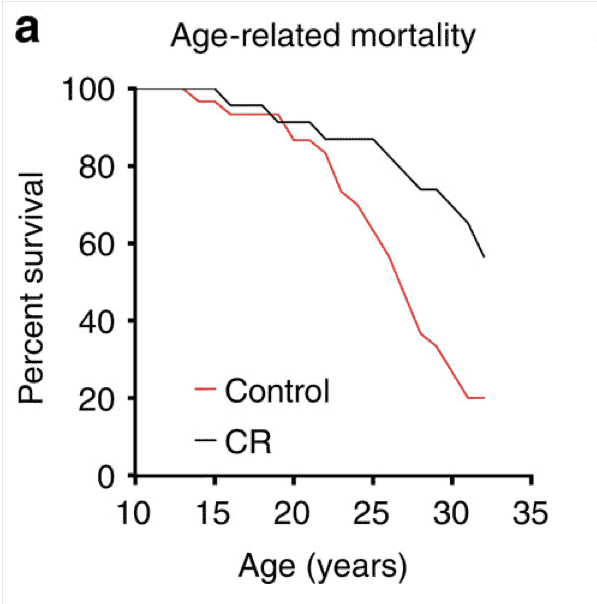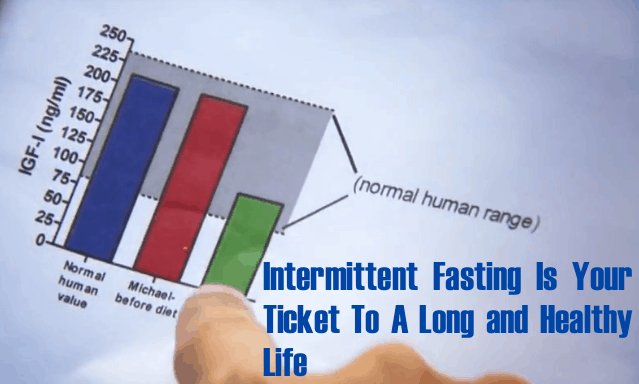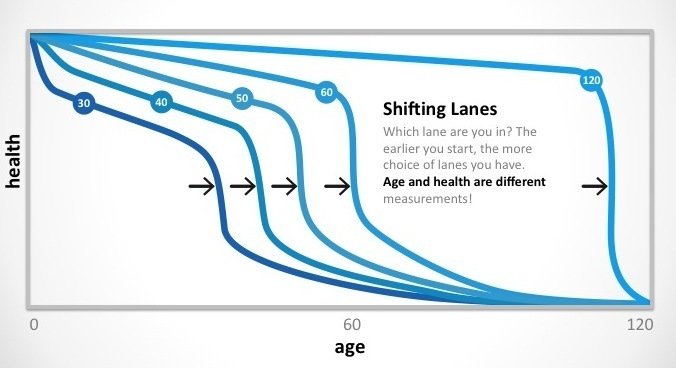Why Intermittent Fasting Is Your Ticket To A Long and Healthy Life
Intermittent Fasting (“IF”) is your ticket to a long and healthy life because it mimics the only proven way to increase lifespan — caloric restriction. CR is very hard. IF can be easy, and the health benefits astounding. Take years off your biological age by selecting the IF program that works for you. Watch!
IF YOU’VE done any reading about how to reliably increase your lifespan, you may have come across studies about — and people experimenting with — calorie restriction (“CR”) via Intermittent Fasting.
The number is 30%.
That’s the sweet spot in terms of percent reduction in calories required for substantial longevity and health benefits.
Problem #1 is, most of us can’t do it.
Flagging discipline might be a reason, but more likely it’s that the benefits and costs are too far apart. You have to be hungry for 30 years before you know it’s working, is how the average person might think about it, but actually, that’s not true, as we’ll soon learn.
Problem #2 is that CR might not increase the lifespan of humans.
Yes, it’s true that rodent studies show that CR can result in a 40% greater lifespan (1), but it gets more complicated with longer-lived mammals. Take Rhesus monkeys for instance. A study published in Nature in 2014 found that “that CR much improves age-related and all-cause survival in monkeys on a long-term ~30% restricted diet since young adulthood”, but unlike with rodent studies, the outcomes showed more variability, as the graph below indicates.
Rhesus Monkey Age-related Mortality
 (source)
(source)
Note that after about 18 years of age, the “survival” rates begin to diverge between monkeys in the “Control” group who eat at will, and those in the “CR” group who eat 30% less. At 27 years, none of the Control monkeys are alive; whereas over 50% of the monkeys in the CR group are alive, 20% of whom live for more than 30 years of age.
Scientists are still studying the potential increase in a human’s lifespan through CR. One such study conducted over a 12 year period by the The Longer Life Longevity Program. Their findings show that:
“CR completely protects against high blood pressure, atherosclerosis/coronary heart disease and diabetes, and that the middle-aged and older CR society members in our study appear 20 to 30 yr younger than their chronological ages in terms of their cardiovascular elasticity, and heart rate variability and gene expression profile in muscle (i.e. markers of aging).” (2)
Sounds great, but again, there’s that Problem #1, which was underscored by “Longer Life Study”:
“It has also become very evident from our experience with the CALERIE study that the great majority of people find CR to be extremely difficult and not feasible long-term.” (2)
So, clearly CR works great to make you healthy and biologically younger, but we don’t yet know to what it extent it will extend the lifespan of humans. If you really want to pickle your brain, read Evolution of Human Longevity Uncoupled from Caloric Restriction Mechanisms, which basically says that it doesn’t appear that the longevity benefits from CR conferred to short-lived mammals (relative to humans) will necessarily be enjoyed by humans, although more systematic studies need to be done.
So why do CR if it’s both difficult and uncertain?
And why did Dr. Michael Mosley twist himself in a knot trying to summon the courage and will to try various CR regimens? (We’ll get to Mosely and his documentary in a moment.)
We’ve already touched on the answer, which is: “healthspan”.
This is healthspan:
Ask somebody you just happen to bump into on the street if he or she wants to live until 100 years of age, and you’ll probably face a scowl and some opprobrium about who would want to be old and feeble. But what if you could be healthy in your twilight years? Perhaps if you could be healthy, you’d want to go deep into the night well past 100.
That graph up there shows bending the age curve. Rather than the typical way of aging whereby our health gets quickly compromised in late middle age and then we hang on in some stupor for another 15 years, bending the age curve implies that we keep on keeping healthy… until the very end.
That’s the promise of CR.
We may not know how valuable CR might be in terms of lengthening our lives, but in just one year or less, people on CR gain many substantial health benefits, such as lower body fat, cholesterol, triglycerides and improved blood sugar, to name a few.
So, given Problem #1 cited above (ie: most of us won’t suffer a 30% reduction in calories), is there a way to get the health benefits of CR without the suffering?
The answer is: Almost.
“Almost”, because there are CR mimic methods that provide real health benefits, but none are without some pangs of hunger, at least initially, as we’ll soon explore.
But first, let’s unwind Dr. Mosely’s “knot”.
Michael Mosley Eats, Gets Hungry and Hopes To Live Longer
British television journalist, producer and presenter, Dr. Michael Mosley wondered if he could reverse three decades of poor lifestyle choices (ie: bad diet and no exercise) by following an Intermittent Fasting program, so he hosted a documentary about it called Eat, Fast & Live Longer.
The Eat, Fast & Live Longer video is below. At the end of it, Dr. Mosley said something I want to underscore, because it may urge you to read the rest of this article, and to watch the documentary.
He said this:
The results have been absolutely fantastic for me, but that does not mean that intermittent fasting will work for everyone. It is really important that they do more trials on humans to find out if in the long-term it is safe and effective. But having experienced intermittent fasting, I plan to go on doing it. It seems to have undone some of the damage that I have done to my body down the years.
Before he chose his particular form of CT, Dr. Mosely’s body was just under 30% fat, though if you saw him, you’d be surprised, because he doesn’t appear fat. He also had:
- High Insulin-like Growth Factor 1 (“IGF-1”);
- High triglycerides;
- High LDL/low HDL; and
- High blood pressure.
Triglycerides are a type of fat (lipid) found in blood. Calories consumed that are not immediately used for energy is converted into and stored as triglycerides in your fat cells. Later, hormones release triglycerides for energy between meals. If you regularly consume more calories than you “burn”, high triglycerides and the inevitable body fat may result. (3)
LDL is “Low Density Lipoprotein”, commonly called the “bad cholesterol”. It’s “bad” because LDL cholesterol is the main source of cholesterol buildup and blockage in the arteries. (4)
HDL is “High Density Lipoprotein”, commonly called the “good cholesterol”. It’s “good” because it helps prevent cholesterol from building up in the arteries. (4)
Blood pressure is determined both by the amount of blood your heart pumps, and the amount of resistance to blood flow in your arteries. The more blood your heart pumps and the narrower your arteries, the higher your blood pressure. Unfortunately, high blood pressure can exist without you knowing it. If uncontrolled high blood pressure increases your risk of serious health problems, including heart attack and stroke. (5)
I’ve saved describing IGF-1 for last, because there’s confusion about it for the simple reason that it’s very complicated.
This is what the National Institute of Health says about IGF-1:
“IGF-1 is an important growth hormone [“GH’], mediating the protein anabolic and linear growth promoting effect of pituitary GH.” (6)
Basic Translation: IGF-1 is a hormone that makes human growth hormone more effective.
People who want to grow large and strong muscles often think that it’s a good idea to increase IGF-1 and seek supplements and drugs to do just that. But as Tim Ferriss has said, this is a “Faustian bargain” between longevity and performance. (7)
We want sufficient amounts of IGF-1 in our bodies to help us grow to adulthood, but after that, not so much. The reason for this is that IGF-1 can make everything grow, including cancer.
Suffice to say, given what is known about IGF-1, you cannot optimize both for big muscles and longevity through enhancing IGF-1. For more on this, read The IGF-1 Trade-off: Performance vs Longevity and Dr. Michael Greger’s quick video, IGF-1 as One-Stop Cancer Shop.
As concerns Dr. Michael Mosley, his high IGF-1 levels, combined with the other poor health metrics, meant he was heading for a shorter life span plagued by various chronic diseases.
The three doctors he conferred with about his condition — Drs. Valter Longo, Krista Varady and Luigi Fontana — gave him a green light to try Intermittent Fasting (“IF”).
But which protocol?
There are several ways to go about fasting, such as:
- Don’t eat for some period when it suits you;
- Don’t eat for a day, or more each week;
- Don’t eat between certain hours of each day; and/or
- Some combination of the above.
The life-enhancing question is:
Which one can best mimic the benefits of CR?
In Michael Mosely’s documentary, he tries two forms of IF, kinda. I say “kinda” because the first method he tries isn’t really an IF program per se, but simply was four days of fasting, followed by life as usual.
The second fasting scheme he tried, however, was an IF method that he wound up adopting as a repeatable program, which was “Alternative Fast Day”.
In an Alternative Fast Day program, you eat at will on one day, and restrict your calories on the next day, and so forth.
You can eat any food you want, although, of course, the healthier the better.
For women, the calorie goal is between 400 to 500 calories for the calorie restricted days, and for men, it’s 500 to 600 calories. You can split it up between three, or two meals, or choose to eat just once, say at lunch.
The restricted calorie days are called “Fast Days”, despite the fact that you’re consuming calories. The cool thing about this is that even though you’re not consistently eating 30% less calories every day, or completely fasting (zero calories) on certain days, you still get the health benefits of CR, as I detail below.
And now without further adieu, I present Dr. Michael Mosely and his Eat, Fast & Live Longer video, and after that, some more information about choosing the best IF program for you.
The Trick to Mimic CR is Intermittent Fasting
Remember that Longer Life Longevity Program CR study mentioned earlier? Well, like a lot of researchers in the CR world, they think that some form of IF can be easier to do (higher compliance) than CR, and yet garner similarly excellent results.
Now ongoing, the “Longer Life” IF study is working with middle-aged participants, who were in the high normal to moderately obese weight range. In this case, the IF regimen is to fast for two days per week. The results so far are very promising, given that various biomarkers show that various symptoms of aging are declining. (1)
But what if you would prefer to get all your fasting done in one clump, and not have to do it for two days every week?
Well, Dr. Valter Longo has an IF plan for you.
Dr. Longo was one of three doctors that Michael Mosley consulted. If you watched the video, you saw him. On June 18, 2015, he published results of his IF work in the journal, Cell Metabolism.
In his National Institute on Aging funded IF study, Dr. Longo had participants consume a low-calorie diet for five days every month. Their calories were reduced by 34 to 54 percent of normal, and consisted of a specific composition of proteins, carbohydrates, fats and micronutrients. They ate per usual the rest of the month. (8)
Seems almost too easy.
Was it too easy to make a difference?
You decide: After three months, participants decreased risk factors and biomarkers for aging, diabetes, cardiovascular disease and cancer with no major adverse side effects.
Thus, it seems promising that if IF mimics the health and longevity biomarkers of life extension; surely, it promotes a better healthspan.
So, do you want to try IF?
Examine the following infographic, courtesy of Dr. Joseph Mercola, and then read the next section about what may work for you.

Choose An Intermittent Fasting Method That Can Work For You
If you’re healthy, not pregnant, and get a pass from your doctor, the first thing to think about is what form of IF can you stick with. You have to make it a part of your lifestyle to get the benefits.
I went through a time when I would completely fast (just sipping medicinal teas) every Monday, and maintained a pretty good diet the rest of the week. In addition, about every quarter I’d do a detox cleanse for seven or more days, part of which was a fast.
Lately, I’ve done a type of IF that cycles in and out of eating every day. I stop eating at 8:00 PM and resume eating at 1:00 PM the next day. That’s 18 hours of every 24 whereby my body can rest from digesting, and turn its energy to cleaning out cellular debris and other good things that promote longevity and healthspan.
However, though I may be hale, this IF regimen of mine hasn’t trimmed the fat much. I think the reason is that I’ve gotten into a habit of doing Dave Asprey’s “Bulletproof Coffee” thing.
Inspired by Tibetans who regularly drink yak butter in their tea, Dave popularized drinking high grade coffee blended with organic butter and coconut oil. Combined with the IF routine I’m doing, the idea is that the fats and the coffee will fuel you through the morning till you eat in the afternoon, which it does.
But there may be a problem — fat has a lot of calories. Even though I just use 1.5 tablespoons of coconut oil (no butter), it amounts to 200 calories, which may cut the fat-burning affects of the “fasting” period.
If you try the 18 hours no-eat IF program, try substituting MCT oil for coconut oil. I have yet to try it, but Dave Asprey says this has improved his results. Also, recognize that our bodies are excellent at adjusting to whatever you throw at it — the body strives for homeostasis: “The property of a system in which variables are regulated so that internal conditions remain stable and relatively constant.” (9)
In may case, and keeping the homeostasis principle in mind, I might have to both get rid of the coconut oil in my coffee and have a splurge day once per week. I think as long as the splurge day is right before or during an exercise day, It might actually make my IF program more effective, and help me cut some body fat.
Read my article, Choose Your Favorite Intermittent Fasting Protocol.
Your Takeaway
Congratulations if you’ve made it this far!
Here are seven things for you to remember and consider doing to increase your healthspan, and maybe your lifespan too:
- Make sure you’re healthy enough to experiment with diet/fasting.
- Determine what fasting/reduced eating schedule best comports to your lifestyle and comfort level.
- Choose between reduced calories over consecutive days each month, no calories for one day per week, or daily abstinence from food over a set period of hours.
- Ensure you always get a good balance of healthy protein, carbs and fat.
- Recruit a friend to do it with you so you can encourage each other and exchange notes.
- Experiment with different IF programs to find the one you’ll stick with.
- Do it with a light heart.
Let us know in the Comments below what you think of all this, and which type of IF program might work for you.
Read: The Truth About Fasting
Last Updated on June 21, 2022 by Joe Garma





